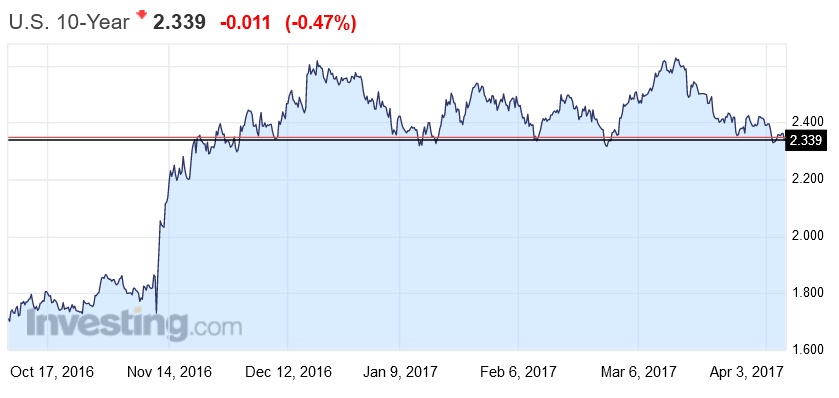The minutes of the US Federal Open Market Committee March 14–15, 2017 have been released. They provide context for the rate decision. All but
one member agreed to raise the target range for the federal funds rate to ¾ to 1 percent. We also got some impressions on how the FED will manage the billions of dollars in assets it purchased in an attempt to reflate the economy after the financial crisis. This is a big deal, with global consequences for financial markets. Not least, think about how expected future rate rises may interact with reducing asset purchases. Bond prices may be impacted. The US T10 was down a little.
In the U.S. economic projection prepared by the staff for the March FOMC meeting, the near-term forecast for real GDP growth was a little weaker, on net, than in the previous projection. Real GDP was expected to expand at a slower rate in the first quarter than in the fourth quarter, reflecting some data for January that were judged to be transitorily weak, but growth was projected to move back up in the second quarter.
Recent information on housing activity suggested that residential investment increased at a solid pace early in the year. Starts for both new single-family homes and multifamily units strengthened in the fourth quarter and remained near those levels in January. Issuance of building permits for new single-family homes—which tends to be a reliable indicator of the underlying trend in construction—also moved up in the fourth quarter and remained near that level in January. Sales of existing homes rose in January, while new home sales maintained their fourth-quarter pace.
The open market reinvestment operations, are currently supporting the financial markets in the US, and are having global impact on interest rate and bond benchmarks. When the time comes to implement a change to reinvestment policy, participants generally preferred to phase out or cease reinvestments of both Treasury securities and agency MBS.
The staff provided several briefings that summarized issues related to potential changes to the Committee’s policy of reinvesting principal payments from securities held in the System Open Market Account (SOMA). These briefings discussed the macroeconomic implications of alternative strategies the Committee could employ with respect to reinvestments, including making the timing of an end to reinvestments either date dependent or dependent on economic conditions.
The briefings also considered the advantages and disadvantages of phasing out reinvestments or ending them all at once as well as whether using the same approach would be appropriate for both Treasury securities and agency mortgage-backed securities (MBS). In their discussion, policymakers reaffirmed the approach to balance sheet normalization articulated in the Committee’s Policy Normalization Principles and Plans announced in September 2014. In particular, participants agreed that reductions in the Federal Reserve’s securities holdings should be gradual and predictable, and accomplished primarily by phasing out reinvestments of principal received from those holdings. Most participants expressed the view that changes in the target range for the federal funds rate should be the primary means for adjusting the stance of monetary policy when the federal funds rate was above its effective lower bound. A number of participants indicated that the Committee should resume asset purchases only if substantially adverse economic circumstances warranted greater monetary policy accommodation than could be provided by lowering the federal funds rate to the effective lower bound. Moreover, it was noted that the Committee’s policy of maintaining reinvestments until normalization of the level of the federal funds rate was well under way had supported the smooth and effective conduct of monetary policy and had helped maintain accommodative financial conditions.


One thought on “Fed Minutes From March Meeting – Financial Market Impact”